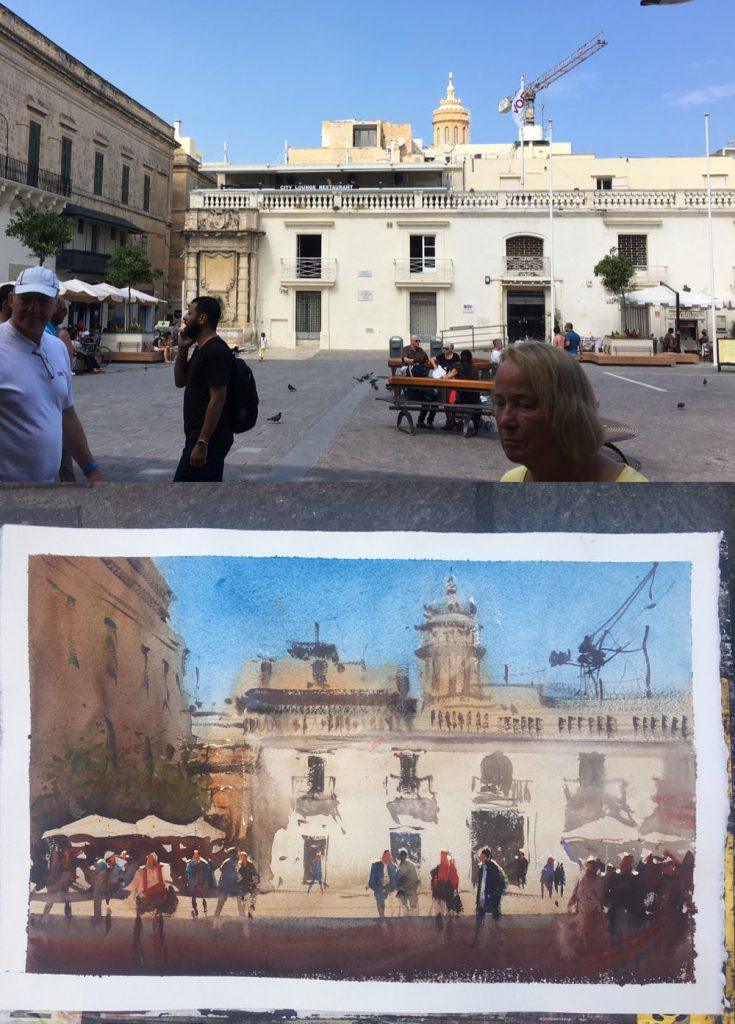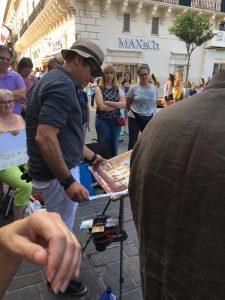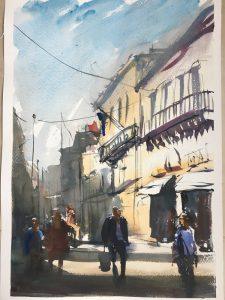Malta on 24 September 2016. First we got to meet Alvaro in a conference room at the hotel. We were about 20 participants from different parts of the world who sat quietly and listened to one of the world’s best watercolor painters. Alvaro talked for almost an hour about watercolor, how to paint, colors, what to think about and much more. Afterwards, I handed him my book, Obsessed with Watercolor. I had promised him it because I got to use some of his pictures in the book.

Then we took the bus to Valletta and we walked into the city center. Alvaro wanted an open place that was also shaded out of consideration for all of us. It was a sunny day. He stopped at St George’s Square, a large square in front of the presidential palace. He had never visited Valletta before and it was fascinating how quickly he picked a subject and started sketching. Most things went very quickly, he was careful with a small church tower that was visible behind the buildings. He first drew the large areas and then quickly drew some people in the foreground. He also marked the location of the shadow in the foreground, simply a line.
Bernd Klimmer, the man who arranged both this workshop and many others with Alvaro, told us that Alvaro never makes a mistake. It quickly turned out that he was wrong. After Alvaro applied a first wash he found the white building to be too dark and he was forced to add a layer of white. After the first layer dried, he then quickly painted the people in the foreground. Working long and carefully on the building on the left, he completed the painting bit by bit. It was interesting to see because I myself tend to dab a little everywhere on my paintings. The watercolor looked doubtful for a long time, but finally turned out amazingly well.
He then talked about his image, about the distribution of warm and cold, dark and light, the shapes, 80/20, or 70/30, maybe 60/40 but never 50/50. To paint with as few brushstrokes as possible. Make a car with 100 brushstrokes, is not good, 40, redo, 10 can be okay. He joked with us that afterwards we would go up and stand in line and photograph his painting, which we also did every time he finished painting. This annoyed him a little.
Then we would paint ourselves. I didn’t want to paint the same motif so I painted in a different direction. Then Alvaro came and went around giving tips to everyone. He thought mine was too dark at the top. He took water and paper and rubbed it away at the top right. He connected the background with the house with dark color. Everything must be connected, he said. I had three guys in the foreground, evenly spaced, it wasn’t good and he painted another one there. He also darkened my figures. I never usually paint on my students’ pictures, but with Alvaro it felt okay.

Then we went to StJohns Square, a smaller square with a lot of restaurants and umbrellas. Alvaro had problems and the background became too strong, he struggled for a long time to get it. Finally he took a flower sprayer and flushed most of it away. It didn’t look good and I thought even Alvaro looked doubtful. But he said this will be fine, just wait. Very true, he finished everything with a lot of drybrush at the end. Here it turned out to be a gloomy background and an almost white surface with sloppy figures with a lot of drybrush. Afterwards, Alvaro talked about composition. His image consisted of two surfaces, the large surface was 80%, the less bright 20%.
After this we had to paint again. I painted in a different direction, a church with scaffolding and a couple of figures. Alvaro’s comments were that the scaffolding lacked significance and wondered why I painted this. The figures were good, he said, but one more, a larger figure, was needed in front of the church.
Scroll on to see what we did the other days.
Gadnell's Watercolor Newsletter
In my newsletter, sent out no more than six times a year, you’ll receive:
- Early updates about upcoming courses
- Priority access to new artworks
- Inspiring tips and useful insights into watercolor painting
It’s completely free, and you can unsubscribe at any time.
I warmly welcome you to join the newsletter!
Best regards,
Stefan


